
Slime mold or slime mould is an informal name given to a polyphyletic assemblage of unrelated eukaryotic organisms in the Stramenopiles, Rhizaria, Discoba, Amoebozoa and Holomycota clades. Most are microscopic; those in the Myxogastria form larger plasmodial slime molds visible to the naked eye. The slime mold life cycle includes a free-living single-celled stage and the formation of spores. Spores are often produced in macroscopic multicellular or multinucleate fruiting bodies that may be formed through aggregation or fusion; aggregation is driven by chemical signals called acrasins. Slime molds contribute to the decomposition of dead vegetation; some are parasitic.
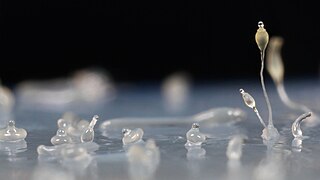
The dictyostelids or cellular slime molds are a group of slime molds or social amoebae.
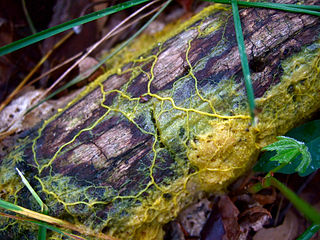
Physarum polycephalum, an acellular slime mold or myxomycete popularly known as "the blob", is a protist with diverse cellular forms and broad geographic distribution. The “acellular” moniker derives from the plasmodial stage of the life cycle: the plasmodium is a bright yellow macroscopic multinucleate coenocyte shaped in a network of interlaced tubes. This stage of the life cycle, along with its preference for damp shady habitats, likely contributed to the original mischaracterization of the organism as a fungus. P. polycephalum is used as a model organism for research into motility, cellular differentiation, chemotaxis, cellular compatibility, and the cell cycle.

Fuligo septica is a species of slime mold, and a member of the class Myxomycetes. It is commonly known as scrambled egg slime, or flowers of tan because of its peculiar yellowish appearance. It is also known as dog vomit slime mold or Jasmine mold and is relatively common with a worldwide distribution, often being found on bark mulch in urban areas after heavy rain or excessive watering. Their spores are produced on or in aerial sporangia and are spread by wind.

Myxogastria/Myxogastrea or Myxomycetes (ICN) is a class of slime molds that contains 5 orders, 14 families, 62 genera, and 888 species. They are colloquially known as the plasmodial or acellular slime moulds.

Trichiales is an order of slime moulds in the phylum Amoebozoa. Trichiales is one of five orders in the group Myxomycetes, or the true plasmodial slime molds. It is also currently categorized under the superorder Lucisporidia with its sister group, Liceales. The order was first described by Thomas MacBride in 1922, and has retained the same name and status as a defined order in present phylogeny. In the plasmodium form, members of Trichiales lack a columella but have a well-developed capillitium for spore dispersal. The shape and details of the capillitium are used to define families within the order. Spores are brightly coloured, ranging from clear, white and yellow to pink and red-brown tones. The order currently has 4 families, 14 genera and 174 species. Recent molecular research has shown that while Trichiales probably represents a true taxonomic group, its sister group Liceales is likely paraphyletic, and it has been suggested that several genera from the Liceales should be reclassified under Trichiales instead.
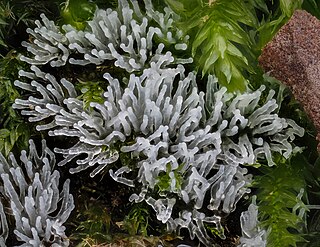
Ceratiomyxa is a genus of plasmodial slime mould within the Eumycetozoa, first described by Pier Antonio Micheli. They are widely distributed and commonly found on decaying wood.
Fonticula is a genus of cellular slime mold which forms a fruiting body in a volcano shape. As long ago as 1979 it has been known to not have a close relationship with either the Dictyosteliida or the Acrasidae, the two well-established groups of cellular slime molds. In 1979, Fonticula was made a new genus of its own due to the unique characteristics of its fruiting body, with only one species: Fonticula alba.
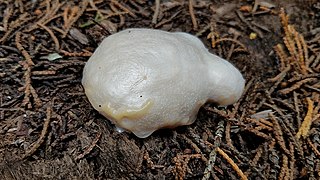
Enteridium lycoperdon, the false puffball, is one of the more obvious species of slime mould or Myxogastria, typically seen in its reproductive phase as a white 'swelling' on standing dead trees in the spring, or on large pieces of fallen wood. Alder is a common host.

Brefeldia maxima is a species of non-parasitic plasmodial slime mold, and a member of the class Myxomycetes. It is commonly known as the tapioca slime mold because of its peculiar pure white, tapioca pudding-like appearance. A common species with a worldwide distribution, particularly in North America and Europe. It is often found on bark after heavy rain or excessive watering. Their spores are produced on or in aerial sporangia and are spread by wind, however beetles of the family Latridiidae are also reported to disperse the spores. Bonner states that soil invertebrates and rain mainly disperse spores as they are sticky and unlikely to be carried by air currents.

Willkommlangea reticulata is a slime mold species from the order Physarales and the only species of the genus Willkommlangea. It is common worldwide, but rare in Europe. The tropics are possibly the main area of habitat.

In true slime molds (myxogastria), lichens, and in species of the family Clavicipitaceae, the hypothallus is the layer on which the fruit body sits, lying in contact with the substrate. The word is derived from the Ancient Greek root hypó ("under") and thallós.

Trichia decipiens is a worldwide widespread slime mould species from the order Trichiida.
Prototrichia metallica is a slime mould species from the order Trichiida and the only species from the genus Prototrichia. It is mainly distributed on mountains.

A plasmodiocarp is a special form of fruit bodies of slime moulds. It is produced if the plasmodium concentrates during the fructification and pull back into the venetion of the plasmodium, from which the fruit body is created. The fruit body traces the process of the venetion, whereby the structure of its subsurface becomes plainly strand-shaped, branched, net or ring-shaped. The production of plasmodiocarps can be generic, or can be also caused by the deranged development of sporocarps or aethalia.
Barbeyella minutissima is a slime mould species of the order Echinosteliales, and the only species of the genus Barbeyella. First described in 1914 from the Jura mountains, its habitat is restricted to montane spruce and spruce-fir forests of the Northern Hemisphere, where it has been recorded from Asia, Europe, and North America. It typically colonises slimy, algae-covered logs that have lost their bark and have been partially to completely covered by liverworts. The sporangia are roughly spherical, up to 0.2 mm in diameter, and supported by a thin stalk up to 0.7 mm tall. After the spores have developed, the walls of the sporangia split open into lobes. The species is one of the smallest members of the Myxogastria and is considered rare.
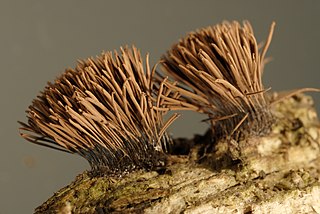
Stemonitis axifera is a species of slime mold. It fruits in clusters on dead wood, and has distinctive tall reddish-brown sporangia, supported on slender stalks.

Elaeomyxa is a genus of slime molds in the family Lamprodermataceae. As of May 2022, there are four known species in the genus. Species in this genus have been documented in North America, Eurasia, Africa, and Australasia.

Trichia crateriformis is a slime mold species in the order Trichiida found in temperate areas throughout the world.
















